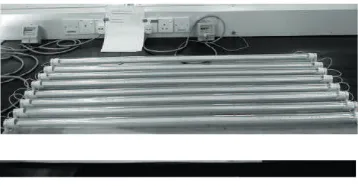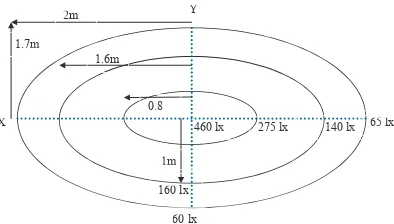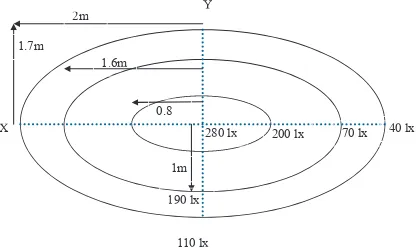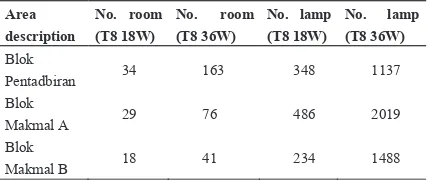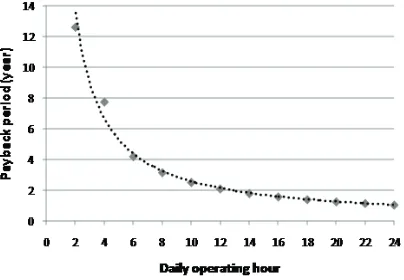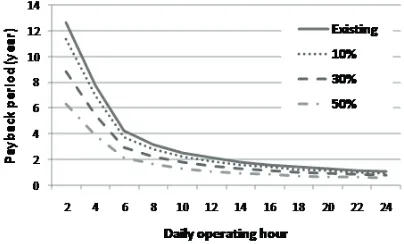Procedia Engineering 53 ( 2013 ) 208 – 216
1877-7058 © 2013 The Authors. Published by Elsevier Ltd.
Selection and peer-review under responsibility of the Research Management & Innovation Centre, Universiti Malaysia Perlis doi: 10.1016/j.proeng.2013.02.028
Malaysian Technical Universities Conference on Engineering & Technology 2012, MUCET 2012
Part 1
Electronic and Electrical Engineering
Techno-economic Analysis of LED Lighting: A Case Study in
Chin Kim Ganª* , Ahmad Farid Saparª, Yik Chee Mun
a, Kuan Eng Chong
b aThis paper examines the feasibility of adopting LED lamp in replacing the conventional fluorescent lamp. Analysis and comparison have
also been presented, which focuses on the economic evaluation. In addition, various lighting energy saving strategies have been proposed. The economic benefits of the respective energy saving measures have been successfully quantified. The study suggests that LED tubes has great potential to replace fluorescent lamps, mainly driven by the cost savings.
© 2013 The Authors. Published by Elsevier Ltd.
Selection and/or peer-review under responsibility of the Research Management & Innovation Centre, Universiti Malaysia Perlis.
Keywords: component; Lighting system; LED tubes; Fluorescent lamps
1. Introduction
The recent years are witnessing an increasingly important role assumed by climate change issues in the electrical that energy sector [1-4]. Much of the attentions have been focused on energy efficiency with the common target to reduce greenhouse gases emissions. This has led to the development of various emerging technologies, which are energy efficient and able to reduce energy consumption, such as solar photovoltaic (PV) and light-emitting diode (LED) [5-9]. It is expected utilising such emerging green technology in an early stage will incur much higher upfront investment cost, which may become the barrier for its large-scale implementation. However, the associated costs saving and environmental benefits of
* Corresponding author.E-mail address:[email protected] © 2013 The Authors. Published by Elsevier Ltd.
implementing energy efficient technology over the longer-term period may be significant [10]. Therefore, the life-cycle cost methodology [11], which considers both operational and investment cost over the technical lifetime of equipment should be applied in justifying the expenditure into the implementation of various energy efficient technologies.
In light of this, it becomes imperative that the manufacturers should have the relevant tools and analysis framework that are capable of evaluating the costs and benefits of up-taking energy efficient technologies. This is important to ensure that the most cost effective and efficient integration of system design is adopted [12].
In view of the Malaysian context, lighting is one of the major uses of electricity and accounts for approximately 17% of national electricity usage [13]. Thus, the use of higher efficiency lighting systems such as LED offers significant potential for electricity saving, and reduces CO2 emissions. Therefore, this project aims to investigate the efficient integration of -economic of integrating light-emitting diode (LED) for lighting purposes are evaluated on the existing system. The findings are expected to be beneficial to assist management in the decision-making process on the choice of several feasible options, hence provides significant opportunities for industry consultation in relation to establishing a business case for efficient integration of green technologies.
This paper examines the feasibility of LED lamp in replacing the conventional fluorescent lamp. Analysis and comparison have been carried out on the two lighting systems in terms of electrical and photometrical performance. A case
energy saving strategies have been proposed. Subsequently, the economic benefits of the respective energy saving strategy have been quantified.
2.Lighting Systems Characteristics
2.1 Lumen
Lumen is the SI units for luminous flux, which is the quantity of light emitted by a source or the quantity of light received by a surface. Typical values of luminous flux emitted by some common sources of light are given in Table 1
Table 1: Number luminous flux emitted by common light sources
Lamp Lamp Wattage Lumens
Incandescent lamp 75W 950
Compact
Fluorescent lamp 15W 810
Fluorescent lamp 36W 2,400
LED 18W 1,600
2.2 Lux
Lux is the SI unit for illuminance, which is a measure of the direct illumination on a surface area of one square meter. One lux is one lumen/m2. Some typical lux values are given in Table 2.
Table 2: Recommendation average illuminance levels based on malaysian standard (ms1525:2007) [14]
Task Illuminance
100 Interior walkway and car-park,
hotel bedroom, lift interior,
corridor, passageways, stairs,
entrance and exits and etc
Lighting for working interiors
and library
3. Technical Comparison Between LED and Flourescent Lighting System
3.1 Laboratory measurement and verfication
Laboratory work has been carried out to evaluate the technical differences between LED and fluorescent lighting in terms of energy consumption, power factor and operating current and harmonics. Both lighting system consist of eight T8 type lighting tube of which the manufacturers specified power rating is 36W for fluorescent tube and 18W for LED eco-tube respectively. Energy meter and power quality meter (Fluke 43B) were used to measure the relevant electrical parameters as mentioned above. Fig.1shows the laboratory testing setup for the LED and fluorescent lighting tube.
Fig. 1. LED (top) and fluorescent (below) lighting system testing setup.
As can be observed from Table 3 below, LED lighting has superior power factor performance in the range of 0.93 0.99 over the fluorescent lighting of 0.59 0.69. The magnetic ballast used in the fluorescent lighting is the main culprit that contributes to the low power factor performance of fluorescent lighting system. From the measurement, it can be shown that the input power rating of LED lighting uses only about 45% of fluorescent lighting system. It is important to note that the ballast used in the fluorescent lighting system has further contributed for about 6W towards to total wattage used in the fluorescent lighting system. However, the major drawback of the LED lighting is the increased level of total harmonic distortion (THD) content in the current waveform, which is undesirable in the electricity system. Nevertheless, the THD of the LED lighting is expected to be continuously improved from rigorous research activities on LED around the world.
Table 3: Electrical characteristics comparison of led and fluorescent lighting system
Criteria LED Fluorescent
Power Factor (PF) Single tube 0.99 0.69
8 tubes 0.93 0.59
Input power rating (W) 18.59 41.67
Operating RMS current (A) 0.08 0.23
Current harmonics (%) 29.4 14.8
Voltage harmonics (%) 1.0 1.0
Fig. 2. Energy consumption comparison for fluorescent and LED lighting system.
3.2 Photometry comparision
The electrical performance of the LED lighting system discussed in the previous section has been encouraging. The LED lighting shows great potential to replace the traditional fluorescent tube as the future lighting system. However, another important aspect that needs to be taken into consideration is the photometry performance of the LED tube. The quality of a luminaires depends on the luminous flux, illuminance and luminance intensity. In this regards, photometry lighting system comparison has been carried out to compare the luminance of both lighting system in different angle. The measurement is taken at 1m height from light source. The light distribution and illuminance intensity of LED and fluorescent lighting are as shown in
Fig.3and Fig.4, respectively.
Fig. 3. Photometry lighting system of LED tube.
X
Y
1.7m 2m
1.6m
0.8
460 lx 275 lx 140 lx 65 lx6
60 lx 160 lx
Fig. 4. Photometry lighting system of fluorescent tube
It is interesting to note from Fig.5that LED tube shows very high illuminance (460 lux) at the area 0m x 0m or directly under the light source, if compare to fluorescent tube (280 lux). From the measurement, it is also shown that LED tube is lacking of light spread in the Y direction.
Fig. 5.Summary of photometry lighting system comparison.
4. Case Study
The technical analysis that has been performed in this study shows promising result for LED to replace the existing conventional fluorescent lighting. In light of this, a case study based on three block buildings at the Faculty of Electrical Engineering, UTeM has been carried out to further demonstrate the economic implications of the LED lighting over the fluorescent lighting. The number of rooms and the number of existing lighting has been estimated from the building floor plan issued by the UTeM Development Office, as well as by conducting a walking audit. It is important to highlight that this study does not intend to provide exact economic calculation based on the very detailed lighting data, but rather to give some high level indications on the order of magnitude the LED lighting can achieve, in terms of energy reduction, payback period and etc.
As can be seen from Table 4 below, the majority of the existing lighting consists of T8, 36W (4 feet fluorescent lighting tube). Only about 20% of the total lighting uses the T8, 18W type (2 feet fluorescent lighting tube).
Table 5 provides the estimated annual electricity bill that comes from lighting in these three block buildings.
X 1.7m
1.6m
0.8
280 lx 200 lx 70 lx 40 lx4
110 lx 190 lx
1m
Table 4: Number of rooms and estimated t8 lamps (18w and 36w types) at selected faculty buildings
Table 5: Total estimated required power rating and annual electricity bill of the existing lighting system
Area description Power rating (kW)
Estimated electricity bill (RM/year)
Blok Pentadbiran 62 69,742
Blok Makmal A 106 118,581
Blok Makmal B 75 82,442
Apart from merely utilizing LED tube, other strategies to reduce the energy consumption were also proposed. The first method is by installing the motion sensor or infrared sensor in the dedicated area, such as hallway, so that the usage of the lamps can be optimised and hence reduce the overall energy consumption. The second method is by replacing all the existing T8 fluorescent lamps in the case study buildings with T5 tube (retrofit). This retrofitting can be easily implemented by using the existing T8 lighting fitting and casing. This method will reduce the wattage of the lamp from 46W to 28W, which could potential brings approximately 40% energy saving. The third method is the combination of TL5 tube with the sensor. This method shall reduce both lamp wattage and hour of usage. The fourth method is by replacing the T8 tube with the LED T8 tube. LED T8 tube is approximately 60% more efficient than T8 tube. The wattage of the LED T8 tube is only 18W as compared with the T8 tube of 46W. Besides that, the illuminance level for LED T8 tube is greater than T5 and T8 fluorescent. Lastly, the fifth method is the combination of LED T8 tube with motion or infrared sensor.
By assuming nine (9) hours operating hours a day and 23 working days a month,
Table 6 shows the annual electricity bill and the percentage of reduction in the total energy consumption for the above mentioned energy saving strategies. Electricity tariff used is RM 0.43/kWh (Tariff B - Low Voltage Commercial Tariff). It is interesting to observe that the inclusion on sensor into the existing T8 system can bring significant reduction of about 36%. As expected, the LED T8 and LED T8 with sensor bring highest electricity bill reduction of approximately 64% and 76%, respectively.
Table 6: Reduction in energy consumption by considering various saving strategies
Given the market price of LED T8 tube is about five times higher than the matured T8 lighting system (tube, ballast and starter), it would be interesting to estimate the payback period of retrofitting the existing fluorescent T8 to LED T8 tube. In this regard, simple payback period analysis has been carried out and considering different operating hours. As shown in
Fig.6, the relationship between the payback period and the daily lighting operating hours is highly nonlinear and can be described by the following power type equation:
) 032)) . 1 (
64
.
27
h
N
(1)Where:
N= Payback period [year]
h= Lighting daily operating hour [hour]
If the operating hours of a lighting application are known, one can quickly estimate the simple payback period of investing in LED T8 tube by using the formula derived above. This is very useful especially when the rough estimate is needed before going into the detailed feasibility economic analysis.
Fig. 6.Simple payback period for LED T8 over fluorescent T8.
One important observation from
Fig.6is that the LED lighting is unlikely to bring substantial economic benefits if it is operated for less than six hours a day. For the lighting applications requiring very short operating hour, for example in a storeroom, it may require more than ten years for the return of investment in the LED lighting system (assuming two operating hours per day). On the other hand, lighting applications which requires long daily operating hours shall achieve significant economic benefits in the long term.
It is expected that the price of LED tube should decrease over the years, driven by the maturity of the technology and the increasing LED uptake by consumers [15]. Hence, a sensitivity analysis of the payback period on the future LED tube price reduction versus different lighting operating hours has also been carried out. This is shown in
Fig.7. It can be observed from
Fig. 7. Sensitivity of simple payback period against projected percentage of reduction in LED lighting cost.
5. Conclusion
The presented study and analysis suggest that LED tube has great potential to replace the conventional fluorescent lamp, mainly driven by the power reduction savings associated with a one-to-one lamp replacement (or retrofit). However, the consumers should be aware of the inherent characteristics of the LED lamps, such as poorer total harmonic distortion performance and the quantity and quality of illumination level on the work plane. The study also shows that the integration of motion or infrared sensors to the existing fluorescent T8 lighting in building can further bring significant economic benefits. Future work is now being planned to replace the existing fluorescent lighting at a dedicated area of the Faculty building. Psychophysical experiment shall also be carried out to evaluate the performance of the both systems in terms of lighting quality, color quality and general perception.
Acknowledgement
The authors would like to thank Mr. James Wong from LED Vision Sdn Bhd for his advice and support in this project. The PJP (PJP/2011/FKE(35A)S00977) research funding from UTeM is gratefully acknowledged.
References
[5] N. A. Rahim, K. Chaniag -Phase Seven-Level Grid-Industrial Electronics, vol. 58, no. 6, pp. 2435-2443, Jun. 2011.
[6] ng the performance of amorphous and crystalline silicon based photovoltaic
-1747, Mar. 2011.
[7] W.R. Ryckaert, K.A.G. Smet, I.A.A. Roelandts, M. Van Gils, P. Hanselaer, Linear LED tubes versus fluorescent lamps: An evaluation, Energy and Buildings, Volume 49, June 2012, pp 429-436.
[8] Esch, J.; , "Prolog to The Transition to Solid-State Lighting," Proceedings of the IEEE , vol.97, no.3, pp.478-480, March 2009
[9] Azevedo, I.L.; Morgan, M.G.; Morgan, F.; , "The Transition to Solid-State Lighting," Proceedings of the IEEE , vol.97, no.3, pp.481-510, March 2009
[10] art II: Discrete
-56.
[11] - leaner Production,
vol. 18, Sep. 2010, pp. 1464-1477.
[12] Fifth IASTED
International Conference on European Power and Energy Systems, pp. 518-523, June 15-17, 2005.
[15] Solid-state lighting research and development portfolio: Multi-
![Table 2: Recommendation average illuminance levels based on malaysian standard (ms1525:2007) [14]](https://thumb-ap.123doks.com/thumbv2/123dok/535191.62107/2.544.176.373.384.454/table-recommendation-average-illuminance-levels-based-malaysian-standard.webp)
